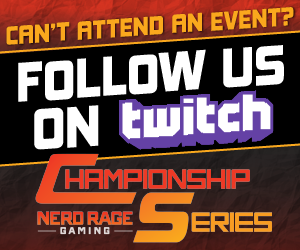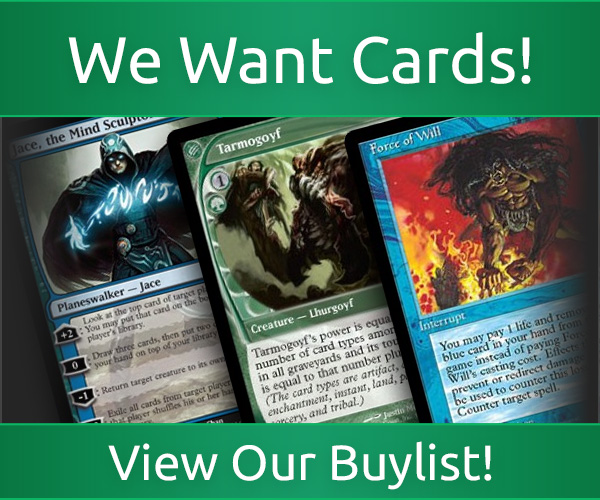Erin Campbell: A Fine Vintage of Dredge
If you have ever listened to one of my many podcasts, including Magic Mics and/or The Girlfriend Bracket, then you would know that I’m a huge fan of Dredge decks.
I love playing Dredge decks because they break many of the fundamental rules of Magic. We’re taught that you’re supposed to draw only one card per turn. With a Dredge card in your graveyard, you can effectively draw more than that. We’re taught that you have to cast spells, and that you need lands and mana to do so. Much of what Dredge does involves triggered abilities (e.g., Bloodghast or Ichorid), or paying Flashback costs, which are paid for by sacrificing creatures (e.g., Cabal Therapy or Dread Return). Creatures that go into the graveyard are supposed to stay there. But Dredge can bring back its creatures again and again.
I have played Dredge to various degrees of success in both Modern and Legacy. But up until recently, I had not had much experience playing Dredge in Vintage. This is due to a combination of factors. For starters, there isn’t much of a Vintage scene where I live. Second, the most important card in Vintage Dredge, Bazaar of Baghdad, retails for anywhere from $400 to $600 each. These are both very real barriers to entry.
degrees of success in both Modern and Legacy. But up until recently, I had not had much experience playing Dredge in Vintage. This is due to a combination of factors. For starters, there isn’t much of a Vintage scene where I live. Second, the most important card in Vintage Dredge, Bazaar of Baghdad, retails for anywhere from $400 to $600 each. These are both very real barriers to entry.
As luck would have it, Channel Fireball was offering Vintage events Thursday through Sunday at Grand Prix Vegas, and my boyfriend was able to get a good deal on a playset of Bazaar of Baghdad. Thursday and Friday were spent hosting panels, but I signed up for the Saturday Vintage event, and got to work figuring out what list I wanted to register.
Vintage Dredge tends to fall into one of two categories. One is called “Pitch Dredge,” which includes Force of Will in the main deck, and a transformational sideboard which includes Dark Depths and Thespian Stage. Boarding into a Marit Lage deck allows you to get around graveyard hate that your opponents are sure to have. The second is the more traditional anti-hate plan, with cards like Chain of Vapor, Ingot Chewer, and Nature’s Claim in the sideboard.
I had experimented with Pitch Dredge on Magic Online, and found it to be terribly awkward. Strip Mine and Wasteland are common, as is Swords to Plowshares. Some decks, such as Paradoxical Storm, can simply kill you before you can even assemble your combo. Pitch Dredge does work, and has the results to back it up. I just don’t feel it works for me. I also feel that Bazaar of Baghdad facilities the anti-hate plan, as it allows you to dig for answers — much like it allows you to assemble the pieces to put Marit Lage into play.
While considering decklists, I reached out to a young man named Steve Walsh, who recently won an Eternal Weekend Trial in Battle Creek, Mich., with Dredge. He shipped me the list he used:

Steve suggested that I replace the lone copy of Elesh Norn, Grand Cenobite with Iona, Shield of Emeria. Elesh Norn is great against Mentor decks and Shops, which are considered to be close, or even fine matchups. However, the Storm matchup is very much a race, and having Iona as a Dread Return target means we can lock our opponent out and close out the game much faster than we could if we were simply on the beatdown plan.
the lone copy of Elesh Norn, Grand Cenobite with Iona, Shield of Emeria. Elesh Norn is great against Mentor decks and Shops, which are considered to be close, or even fine matchups. However, the Storm matchup is very much a race, and having Iona as a Dread Return target means we can lock our opponent out and close out the game much faster than we could if we were simply on the beatdown plan.
Going into round four, I was 3-0 by defeating Shops, Saheeli Oath, and RW Death & Taxes. There was a bonus cut to top 8, which I was able to draw into, and then promptly lost in the first round of the finals to a Leovold deck. Leovold, Emmisary of Trest isn’t typically a card Dredge cares about, as we can simply replace our draws with Dredges, and get around his restriction. However, if you don’t have a Dredger already in the graveyard, and you’re trying to dig for one with Bazaar, Leovold can put a stop to that. If you’re terribly concerned about Leovold, you can try to remove it from your opponent’s hand with Cabal Therapy or Unmask. Or you can bounce it with Chain of Vapor for a temporary reprieve.
Looking back on those four or five rounds, I was surprised by the different kinds of graveyard hate that I ran into and my ability to power through. You can sandbag or choose to keep a spare Dredge card in hand if you see a Nihil Spellbomb or Tormod’s Crypt. You can choose not to Dredge and cast Cabal Therapy first, if you suspect Ravenous Trap. You can even hard cast creatures and make Zombies with Bridge from Below if Grafdigger’s Cage is out.
At no point did I see a piece of graveyard hate and think “it’s all over.” I was confident in my ability to not only board in the right answers to hate, but to find them or switch roles if I needed to (i.e. casting creatures the old fashioned way and going on the offensive).
My luck continued on Sunday, as I went 4-0 — defeating 4 Color Gifts, Paradoxical Storm, and Eldrazi Taxes twice. All of my opponents were incredibly friendly, skilled, and nice enough to answer some questions about sideboarding once our match was over.
Going forward, I would probably play the exact same list. However, I would like to try different sideboard strategies against certain matchups, based on the cards that I saw people bring in against me. For example, I might bring in Barbarian Ring against the Storm decks, as they play black and have access to Yixlid Jailer.
Post-sideboard games are really the true test of a Dredge pilot’s ability – whether it be in Modern, Legacy, or Vintage. Regardless of the format, Dredge is an engine, and it’s important to find the right balance between dealing with potential hate and not slowing down your game plan. Unlike Modern and Legacy Dredge, which often relies on having anti-hate in your opening hand or being at the mercy of top decks, Vintage Dredge has the luxury of playing with Bazaar of Baghdad and being able to dig for answers.
The power of Bazaar of Baghdad, and my experiences at Grand Prix Vegas have inspired me to play more Vintage — both on Magic Online and in paper. I look forward to further playtesting, and comparing notes with more seasoned Dredge pilots to find the ideal list for me.
Thanks for reading!
Erin Campbell is a successful podcaster and creator of “The Deck Tease” and “The Girlfriend Bracket” podcasts. She is currently one-third of the “Magic Mics” podcast, and resides in Milwaukee.



